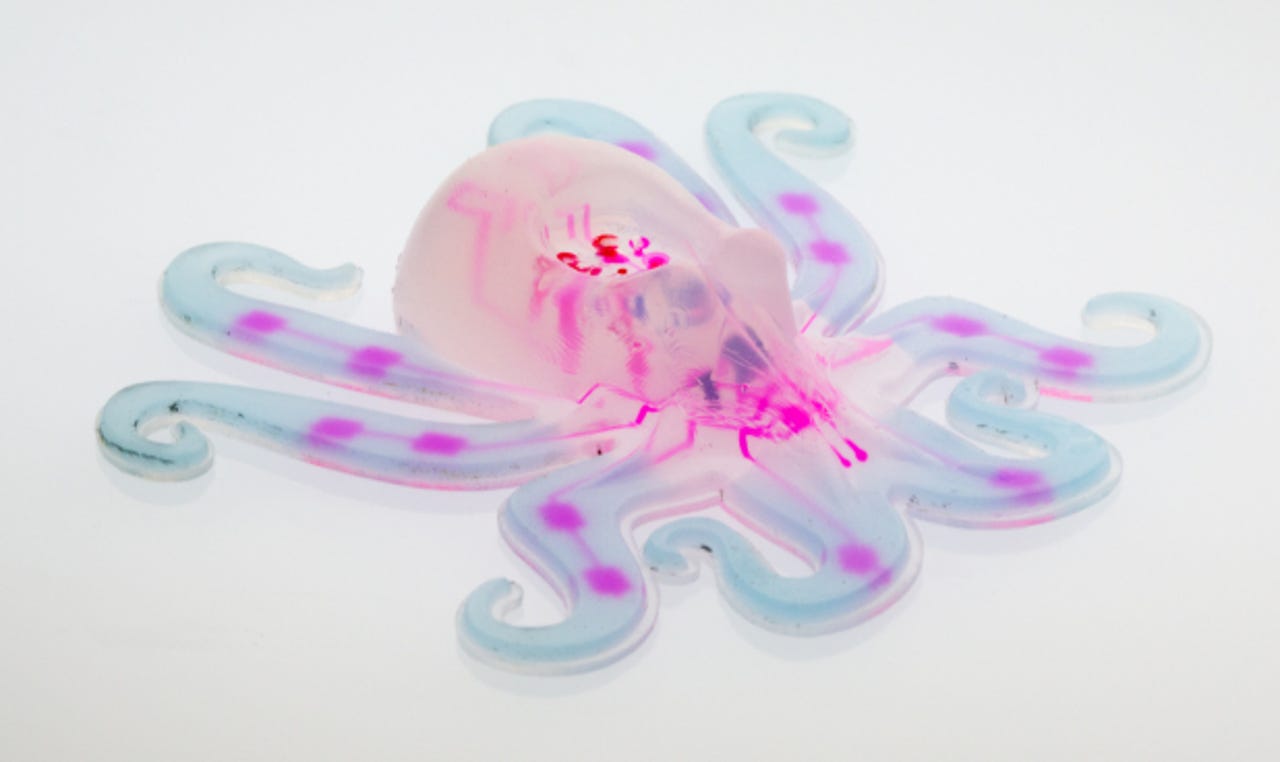The first fully soft autonomous robot is an octopus


Close your eyes, and picture a robot. It's probably hard and angular, with jerky movements that have inspired dancers for decades. But robots can also be flexible, squishy, and graceful. Researchers at Harvard have created the first autonomous robot that is completely soft. Its design is inspired by the octopus -- a creature that is known for its strength and dexterity.
The octopus's qualities are ideal for modern robotics, which require more flexibility than the hulky machines that have dominated industrial settings for more than half a century. Plus, it's a weird and flashy way to demonstrate the advantages of soft robotics, an emerging field dealing with robots that are made of deformable materials.
"The octopus is able to move underwater with various maneuvers, contort its body to squeeze through tight spaces, manipulate objects in its environment, and more, all without a supporting skeleton," says Ryan Truby, a graduate student in Harvard's Lewis lab and co-first author of a paper that describes the "Octobot" project in Nature.
He tells ZDNet, "It's going to be a tremendous challenge to get a conventional robot to achieve all these feats, but soft-bodied robots might just be able to! Thus, the octopus is a key motivator in the field of soft robotics; many see the creation of a truly octopus-like robot as a 'holy grail' for the field."
Robots have previously been used for their strength and ability to endlessly perform repetitive actions with precision. Now, they are starting to be considered for many new purposes, such as assisting in search and rescue missions, working alongside people in factories, and chatting with customers in retail stores.
Soft robotics offer several benefits that traditional robots can't achieve. First and foremost, they are safer. They won't hurt humans or damage their surroundings, so they don't have to be fenced in like classic industrial robots. Hybrid robots made of soft materials with some hard components could be ideal for working alongside humans. They could be used as factory workers, medical devices, or as companions for the elderly.
Soft robots are also flexible enough to squeeze into tight and awkward spaces. Hard robots are known for being durable, but in some ways soft materials are actually more resilient. Soft robots can easily bounce back after a fall, and they are better at traversing difficult environments, such as deserts, piles of rubble, or the ocean floor. For this reason, soft robots are especially promising options for exploring other planets.
The octobot was created using a 3D printing technique called "embedded 3D" or EMB3D printing. Truby explains:
This printing technique allows us to print the features that ultimately become the octobots' actuators, fuel reservoirs, and catalytic chambers (which are needed for fuel decomposition) in a rapid, straightforward, and free-form nature. The octobot has five different materials that comprise its body; rather than printing all of these, our EMB3D printing approach enables us to reduce the number of materials that we need to print to two.
The 3D printing technique enabled the researchers to quickly and easily create prototypes, so they could test many iterations in order to find the best design. Previous attempts at soft robots have relied on rigid components for power and control, such as batteries and circuit boards, which have been considered essential for operations. The authors write in Nature, "Despite recent advances, soft robots must still be tethered to hard robotic control systems and power sources."
Other roboticists around the world have also created octopus robots, such as a team at the BioRobotics Institute at the Scuola Superiore Sant'Anna, in Pisa, Italy. However, Harvard's version stands out because it is 100 percent soft, untethered, and doesn't have any electronics. Their robot is pneumatic-based, meaning it is powered by gas under pressure, so no rigid power sources are needed. A chemical reaction inside the robot transforms liquid fuel into gas, which inflates the robot's arms. A microfluidic logic circuit consisting of a soft analog of a simple electronic oscillator controls the process.
The fully soft design and rapid prototyping approach lays the foundation for completely soft, autonomous robots that could be used for countless new applications in the future.